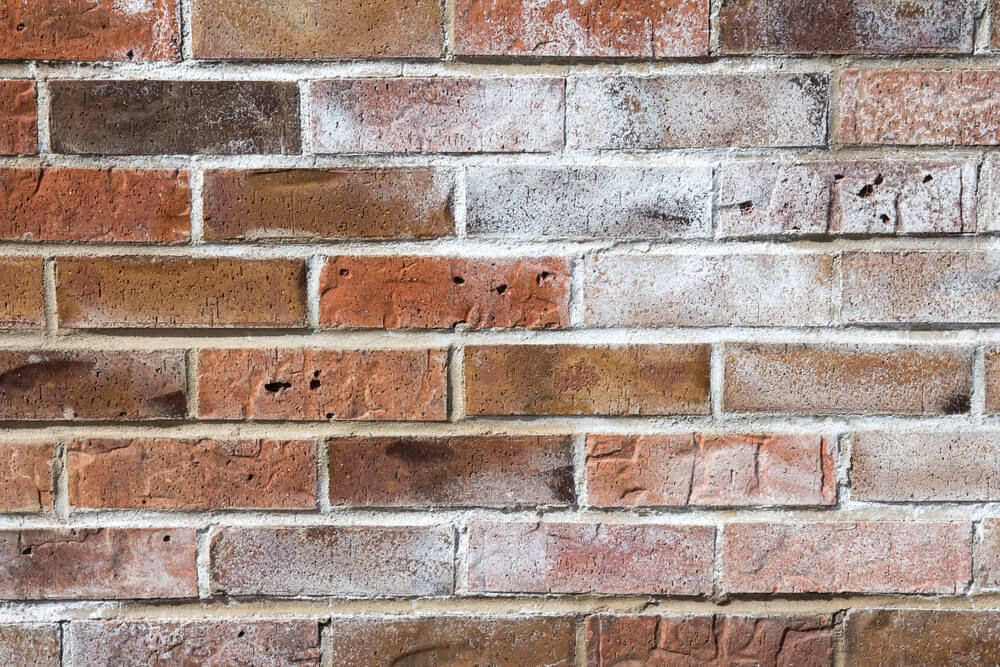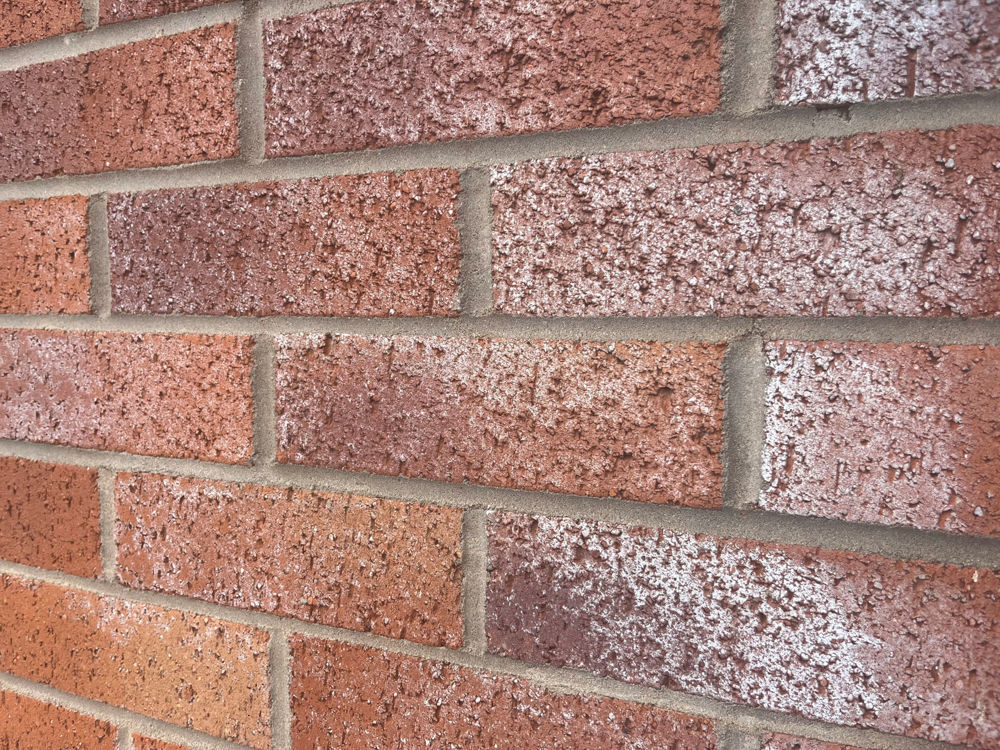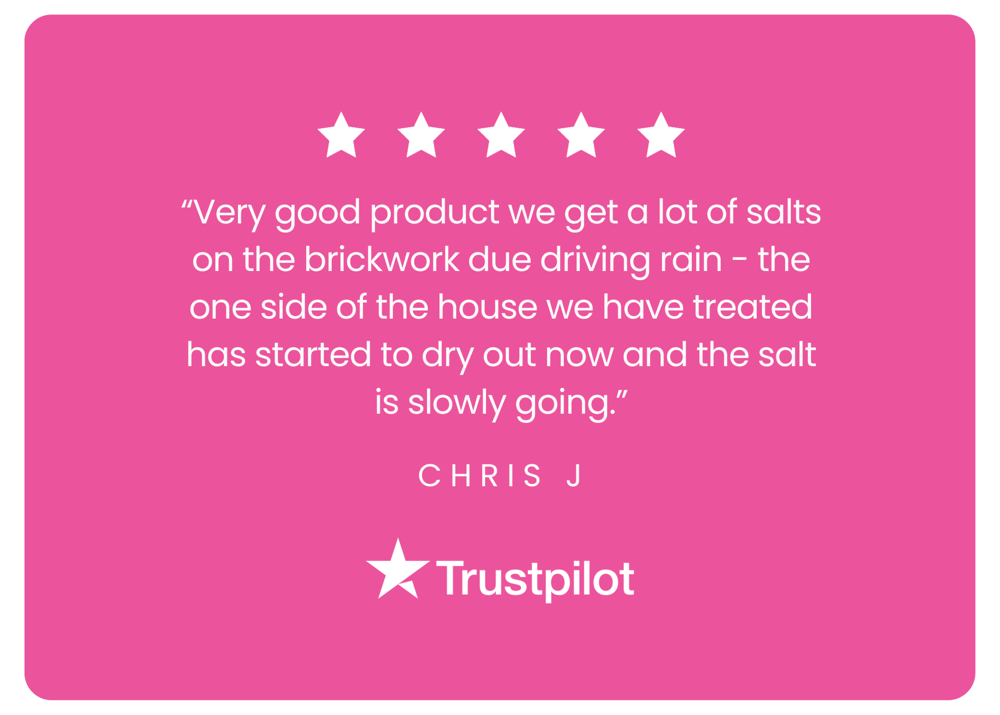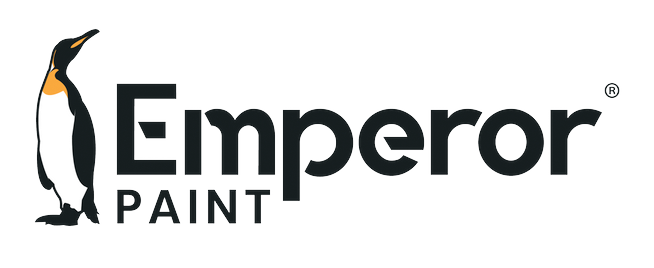
Efflorescence is an extremely common sight for many homeowners, especially here in the UK. Houses with bare brickwork exteriors are often forced to accept the inevitability of this white, powdery substance staining their exterior walls, which is one of the many reasons why rendering a property has grown in popularity.
In this guide we are going to address what efflorescence is, what causes it and the various ways you can remove & treat it, so your brickwork remains looking new & pristine.
What Is Efflorescence?
You may not know what the term efflorescence means, but the chances are you have seen it on natural brickwork all too often. Efflorescence or ‘salt efflorescence’ is a white deposit left on the surface of masonry and other porous materials. It forms white stains on brick and is a common problem in the UK housing stock.
While efflorescence on brick is often not a structural issue, it does compromise the aesthetic appeal of your home. The key point is that the presence of efflorescence is an indication of a much larger issue.

What Causes Efflorescence?
For efflorescence to bloom, it requires salt & water. Building materials such as brick, concrete and stone are porous, meaning water can be absorbed into the structure through a process called ‘capillary action’. This movement of moisture through the brick is what causes the efflorescence, when water soluble salts are absorbed into the building material. When this water evaporates, the salt deposits are drawn to the surface of the substrate, leaving an unsightly white coating as a deposit.
To put simply, efflorescence requires the movement of moisture to occur. Without this, the salt would not migrate through the brickwork & leave staining on the masonry surface.
It is more common after extended periods of heavy weathering or during low temperatures, where building materials become saturated with water over time.
Efflorescence Removal
While you can prevent efflorescence starting in the first place, it is often too late for most people. There are three options for either removing or preventing efflorescence on brick.
In the short term, efflorescence on brick can be removed from your home depending on the extent of the problem.
1. REMOVING LIGHT EFFLORESCENCE - USE A BRUSH
In some cases, using a dry, stiff brush can remove the salt deposits from surface of smooth substrates. This is unlikely to cure the problem but can remove a proportion of the efflorescence.
Ensure you wear protective goggles and mask when brushing the efflorescence as the powdery salt deposits can cause irritation.
.png)
2. REMOVING MORE SUBSTANTIAL EFFLORESCENCE - RINSE WITH WATER
On other surfaces, using a pressure washer can dissolve efflorescence, allowing it to run off. However, these water-soluble salts that caused the efflorescence to begin with can be partially re-absorbed by the building materials, or even bring more of these salts back to the surface as it dries. This means that the process may require multiple brushes and washes to fully remove all deposits.
For a slightly stronger cleaning solution, A 50/50 mix of white vinegar and water can help to spot treat large areas that are prone to salt efflorescence thanks to the acidity in the vinegar.
This can remove any light efflorescence from your brickwork, however this is not a long-term solution to the route cause of the problem. As we have discussed, efflorescence is a sign of a much larger problem. Yes, it is possible to remove efflorescence in small areas, however this will continue to occur until the moisture is resolved.
3. REMOVE AND PREVENT FURTHER SALT - APPLY MASONRY CREAM
The migration of the efflorescence can only be prevented long-term by eliminating the movement of moisture through building materials. This can be done utilising a waterproofing system such as masonry cream that prevents moisture from entering the brickwork.
When researching waterproofing systems for exterior masonry, you are likely to come across what are known as brick or masonry sealers. These are water repellent treatments similar to masonry cream that prevent water from absorbing into the material. Keep in mind that these sealants are different technologies to masonry cream as they create a film on the surface of the wall. This film 'seals' the pores of the masonry, preventing water absorption, but also impacting the breathability of the exterior wall. By impacting the breathability of the wall, you are preventing it from expelling water vapour that naturally builds up inside a property. Over a period of time, this moisture will lead to damp & structural problems such as spalling & cracking brickwork, plus any efflorescence will become trapped underneath the sealant. After a matter of months, this moisture will eventually cause the film of the sealer to break, allowing water to absorb into the brickwork once again. These treatments are not long-term solutions, so be wary if you opt to use one.
Emperor Masonry Creme creates a super hydrophobic surface on exterior walls meaning that water cannot be absorbed by the substrate. The formulation does this by lining the pours of the material, but crucially it does not seal these pours completely, remaining breathable and thus allowing water vapour to escape. This ensures that the surface can breathe, while still maintain a waterproof exterior.
When applied to an efflorescence affected surface, the technology prevents moisture penetrating into the building material, and thus doesn’t allow water-soluble salts from depositing on the surface of your property.
The super hydrophobic surface created is also self-cleaning. As any efflorescence created by previous moisture intrusion forms, it will simply wash away with any rainfall.
This progressively reduces the amount of efflorescence present, as the moisture levels of the building material decreases over time.
An independent, UKAS accredited laboratory conducted a 25-year accelerated weathering test on to establish the performance of our innovative technology. The results were conclusive. The Emperor Paint treated substrates (shown on the right and left hand sides) showed substantially less efflorescence compared to the untreated surface (shown in the middle).

Emperor Paint has been proven not only to provide a long-term preventative solution to brick efflorescence but can also assist in removing the efflorescence gradually through self-cleaning properties.

To remove the efflorescence on the brick correctly, follow our three-step process:
1. BRUSH THE SURFACE
As previously discussed, a stiff brush can remove a large proportion of surface efflorescence on brick. With a dry brush, sweep away the salt deposits, avoiding adding moisture to the surface. If the efflorescence is still substantial, using a pressure washer on a low pressure setting will help to remove further deposits.
Allow the brick wall to completely dry before moving on to further steps, as these must be done on a dry surface. Remember, the Emperor Paint technology will self-clean any further salt deposits once applied, so some persisting, isolated brick efflorescence can remain on the wall when applying the masonry paint.
2. APPLY CLEANER
While ensuring the surface is dry, apply the Emperor Paint Masonry Cleaner. This removes moss and algae while disinfecting, leaving the surface ready to treat.
Ensure that the surface is completely dry before applying the treatment as this will affect the performance of the masonry cream.
3. APPLY MASONRY CREAM
Ensure conditions are dry before beginning painting, this is required to ensure the waterproof masonry paint can correctly cure into the exterior walls. Furthermore, when the temperature is below 5°C Emperor Masonry Creme should not be applied.
Why not read our full guide to applying Emperor Paint products?
.png)
Frequently Asked Questions
Q. WHAT HAPPENS IF YOU PAINT OVER EFFLORESCENCE?
Before painting masonry that is suffering from efflorescence on the brick, you must remove all previous salt deposits as this could impact the ability for the masonry paint to adhere to the wall. If you are applying a masonry cream, you do not need to remove all efflorescence as this will be drawn through the brick and cleaned off easily due to the self-cleaning surface created. This is different to paint as masonry cream does not create a paint film that efflorescence can break.
Q. IS EFFLORESCENCE HARMFUL?
Efflorescence is not dangerous to your health, although it is an indication of potential moisture problems that are harmful to the health of your property. It is crucial to identify efflorescence and solve this moisture before it causes damage.
Q. WILL EFFLORESCENCE GO AWAY?
Efflorescence will not go away of its own accord if the source of the moisture is not resolved. If the source of the moisture is prevented using a treatment such as Emperor Masonry Creme, the efflorescence will gradually reduce over the course of 6-12 months.
Q. CAN YOU PAINT EFFLORESCENCE?
If you apply a standard masonry paint to a bare brick wall that is suffering from efflorescence, the moisture that causes the efflorescence will become trapped in the same way a sealer would trap it. This is because acrylic masonry paint have low breathability, meaning the moisture that transfers the salt becomes trapped, resulting in a build up of the salt. Eventually, the salt blooms & caused the paint film to be breached, causing in the need for remedials. A highly breathable silicone masonry paint like Emperor Masonry Paint allows the water vapour to escape, along with it the salt deposits.
We hope this has answered any questions you may have had regarding efflorescence on brick & how to prevent it. Does your home suffer from brick efflorescence? Prevent this easily and effectively with our highly advanced Emperor Masonry Creme. Alternatively, if you require any help & advice, please contact our team of experts you are on hand to assist you. You can contact them by sending an email to info@emperorpaint.co.uk or by calling 0161 509 9009.

